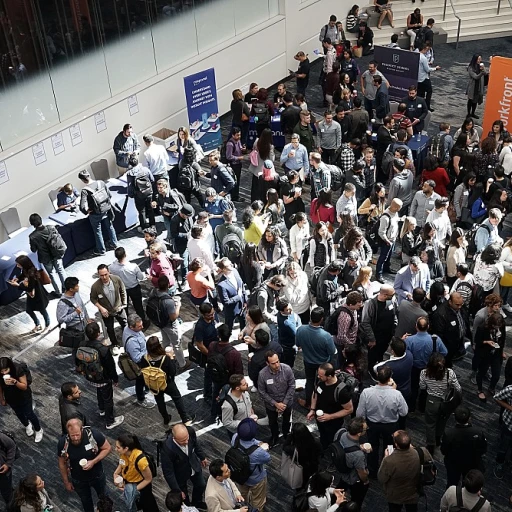Understanding Global Talent Acquisition
Delving into the Essence of Global Talent Acquisition
Global talent acquisition is not merely an expansion of the recruitment process to international borders. It involves a complex and strategic approach that integrates multiple facets of a business to successfully attract and retain top talent worldwide. As globalization continues to blur geographic boundaries, companies are compelled to rethink and redefine their talent acquisition strategies to maintain a competitive edge.
Embracing a global perspective necessitates understanding that it's not just about filling positions; it's about securing the best skillset from around the globe. This requires a nuanced appreciation of the diverse cultures, labor markets, and legal environments that vary from country to country. By mastering these elements, your organization can effectively align its global talent strategy with its overall business goals.
Companies embarking on this journey must be prepared to adapt their existing recruitment frameworks to accommodate new situations arising from their expanded reach. From the technologies employed to the brand image conveyed, each aspect must resonate with a global audience while still remaining true to the company's core values.
For insights into creating a holistic approach to global talent acquisition, check out these
successful talent acquisition strategies that can propel your organization toward a thriving and diverse workforce.
The Recruitment Process: Local vs. Global
Comparing Hiring Practices: Local and International
When developing a strategy for global talent acquisition, understanding the nuances between local and international recruitment processes is crucial. While the fundamental principles of recruitment remain consistent, the approach differs significantly based on location, culture, and legal frameworks.
- Scope and Scale: Local recruitment often involves a smaller talent pool and requires knowledge of local job markets, whereas global recruitment opens up access to a diverse range of candidates but necessitates a broader reach and consideration of various international factors.
- Logistics and Coordination: Coordinating recruitment efforts globally can be complex, involving time zone differences and virtual interviews. Good communication and effective technology use are essential to manage these logistics smoothly.
- Legal Compliance: Each country may have unique labor laws and compliance requirements. Being aware of these laws can prevent legal issues and ensure a smooth onboarding process.
Addressing Barriers to Entry
Recruiting globally means handling various barriers such as language differences, cultural misunderstandings, and diverse industry standards. Addressing these challenges requires strategic planning and adaptability:
- Language and Communication: Implement training programs or provide multilingual support to ensure clear communication and understanding between recruiters and candidates.
- Cultural Sensitivity: Acknowledge and respect cultural differences to create an inclusive recruitment environment. This can involve cultural training for HR teams to better understand diverse cultural backgrounds.
- Industry Standards: Align your recruitment process with international industry standards where necessary to attract top talent familiar with these practices.
Creating a Flexible Recruitment Framework
A flexible recruitment framework is essential to adapt to the dynamic landscape of global talent acquisition. This requires:
- Dynamic Recruitment Policies: Design policies that are adaptable to both local and global contexts. This flexibility can be achieved by regularly reviewing and updating policies to meet changing market demands.
- Technology Integration: Utilizing technology for virtual hiring processes and data analytics can streamline operations and make global hiring more efficient.
- Continuous Learning: Encourage continuous learning and training within your recruitment teams to stay updated on global recruitment best practices.
For further insights, you can learn more about
crafting a winning talent acquisition game plan.
Cultural Integration in Global Teams
Bridging Cultures for Effective Collaboration
When you recruit a global team, cultural diversity becomes a significant asset. However, it also poses challenges in ensuring seamless integration and collaboration among team members from varied backgrounds. Understanding and respecting cultural nuances is crucial for fostering a harmonious work environment.
- Foster Cultural Awareness: Encourage your team to learn about each other's cultures. This can be through workshops, cultural exchanges, or simple discussions about cultural norms and values. Enhancing cultural understanding within your team can help mitigate misunderstandings and build stronger relationships.
- Diverse Communication Styles: Be aware that communication styles differ across cultures. Some cultures may prefer direct communication, while others might find indirect communication more appropriate. Offering training on communication styles can help team members adapt and interact more effectively.
- Promote Inclusion: Ensuring that every team member feels valued and included is vital. This could mean celebrating cultural festivals, encouraging diverse voices in meetings, or having policies that support diversity and inclusion.
- Leverage Technology: Use collaborative tools that support global teams. Technologies such as video conferencing, project management software, and collaborative platforms can bridge the physical distance and foster a sense of unity among your team. As mentioned in the recruitment process, technology plays a key role in connecting diverse talents for effective team dynamics.
Incorporating these practices can transform cultural differences into a strength, allowing your global team to collaborate more efficiently and innovate effectively. Building a successful global team isn’t just about recruiting; it’s about creating an environment where everyone can thrive together.
Navigating International Labor Laws
Addressing Cross-Border Employment Challenges
When engaging in global talent acquisition, it's essential to understand and navigate the complexities of international labor laws. These regulations can vary significantly from one country to another, impacting the recruitment and employment process.
- Understanding Local Labor Laws: Each country has its own set of labor laws that govern employment practices, such as working hours, minimum wage, and employee benefits. To ensure compliance, companies must be informed about these regulations and adapt their hiring practices accordingly.
- Visa and Work Permit Requirements: Securing the right to work in another country involves intricate visa processes. Companies must familiarize themselves with the specific visa requirements for each country they plan to recruit from. This knowledge will help prevent any legal issues that could arise from non-compliance.
- Employment Contracts and Policies: Drafting employment contracts that are compliant with local laws is crucial. This includes understanding mandatory contractual elements, such as probationary periods, notice periods, and termination clauses. Companies should also develop policies that align with both local customs and their global standards.
- Collaborating with Local Experts: To efficiently manage the legalities of international hiring, businesses may benefit from partnering with local legal experts and HR professionals. They can provide insights into local legislation and cultural considerations that impact employment.
Maintaining awareness of these factors not only ensures legal compliance but also helps build a strong foundation for successful global recruitment.
Employer Branding for Global Reach
Building a Strong Global Employer Brand
In the realm of global talent acquisition, establishing a robust employer brand is essential for attracting top-tier candidates from around the world. A strong employer brand not only sets you apart from competitors but also communicates your company’s values, culture, and opportunities to potential employees.
To effectively enhance your global employer brand, consider the following strategies:
- Consistent Messaging: Ensure that your core values and mission are consistently communicated across all international platforms and touchpoints. Consistent messaging helps in building trust and presenting a unified image of your organization worldwide.
- Authentic Representation: Showcase real stories and testimonials from current employees in various global offices. This humanizes your brand and provides candidates with a genuine insight into what it’s like to work for your company in different locations.
- Localized Strategies: While maintaining global consistency, tailor your employer branding efforts to fit cultural nuances and preferences of different regions. This may involve adapting communication styles, benefits offered, and even the visual elements of your brand.
- Engage in Global Talent Communities: Participate in global industry forums, job fairs, and online talent communities. Engaging in these platforms positions your company as an active and reputable player in the global market.
- Leverage Social Media and Digital Platforms: Utilize global social media networks and digital platforms to promote your brand. A strong online presence not only increases visibility but also makes it easier for potential candidates to engage with your company.
Constructing an appealing employer brand on a global scale can be challenging, yet it remains one of the most influential components in securing top talent. By understanding your audience, being consistent yet adaptable, and utilizing the right platforms, you can cultivate an employer brand that resonates worldwide.
Leveraging Technology for Global Recruitment
Embracing Advanced Recruitment Tools
In today's fast-paced world, leveraging technology in global recruitment is no longer optional—it's essential. With the rise of digital platforms and AI-driven tools, organizations have a powerful arsenal at their disposal to streamline the talent acquisition process and ensure they attract the best candidates from around the globe.
- AI-Powered Screening: Artificial intelligence can significantly enhance the candidate screening process by analyzing resumes more efficiently and eliminating biases. This ensures that only the most suitable candidates are shortlisted, saving both time and resources.
- Applicant Tracking Systems (ATS): An ATS is a must-have tool for managing large volumes of applications. It helps HR teams keep track of candidate progress, organize interviews, and communicate seamlessly with applicants.
- Video Interview Platforms: As global teams become the norm, video interviews have transformed recruitment. They allow for a personal interaction with candidates across different time zones, offering a cost-effective and time-saving solution.
Data Analytics for Informed Decisions
Data-driven decision-making is a hallmark of successful global talent acquisition strategies. By analyzing recruitment metrics, organizations can identify trends, improve processes, and predict future hiring needs.
- Tracking Key Metrics: Monitor important indicators such as time-to-hire, cost-per-hire, and candidate satisfaction to optimize recruitment processes.
- Predictive Analytics: Utilize predictive analytics to foresee hiring needs, reducing response time and ensuring that the recruitment pipeline remains robust and proactive.
Expanding Reach with Social Media
Social media platforms are invaluable for reaching a diverse global talent pool. They not only help in advertising job openings but also in building a strong employer brand that resonates with potential candidates worldwide.
- Targeted Job Ads: Platforms like LinkedIn allow for targeted job advertisements that reach the right audience based on their experience, location, and interests.
- Engaging Content: Share content that highlights your company's culture and values. This can attract candidates who align with your organizational ethos and are genuinely interested in being part of your team.








